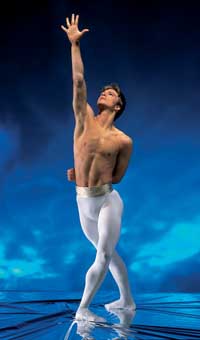Daniel Topolski sees many parallels between the challenges facing sports coaches and dance leaders

Over a weekend in early January 2011 I was invited by DanceEast to join a group of 26 dance leaders drawn from 13 countries at a secluded country location near the market town of Woodbridge in Suffolk. They formed an international think-tank examining new models of working in artistic leadership, drawing on the experiences of other successful leaders from the worlds of the visual arts, theatre, business and sport, as well as dance. Together they discussed leadership, motivation, being a woman in a man’s world, managing rebellion, nurturing artists, team building, risk and communication.
I brought my experiences as a sportsman, broadcaster, writer and former Boat Race and Olympic rowing coach to the group. In sport, coaches – often former athletes – have to undertake a variety of courses to study the complexities of preparing athletes for competition and to hone their teaching skills. They will be constantly re-assessing the way they coach and the techniques they use. I was surprised to find that in dance, artistic directors tend to get thrown in at the deep end with little opportunity to prepare. They learn on the job.
While there are recognised to be many common threads between sport and business, which can inform the way both operate, none of those audiences that I have addressed have responded with quite the same depth as the dance leaders did. I came away from the weekend noting the close parallels in the intensity and arduousness of the training undertaken by both dancers and top athletes, and there was an empathetic recognition of the 26 gruelling years of daily, six-hour training that the rower Sir Steve Redgrave did to become one of the world’s greatest Olympians. However, I also became aware of the differences, particularly in techniques for measuring and monitoring performance success. The reaction to the clips of close races – both Boat Race and Olympic – was strong and visceral from the dance leaders. Here was a potent demonstration of the ultimate judgement – a win or lose world – a very different performance measure to that which an artistic director or a dance leader will make, where the differences between success and or just so-so are harder to define. My explanation about constant evaluation of athletes’ progress in a competitive environment and the detailed and meticulous physiological and psychological assessment and medical monitoring that takes place in a high achieving sporting set up also threw up potential lessons that dance leaders could learn from the field of sport. One of the dance leaders said: “I feel we in dance are ten, maybe even thirty years behind in this area.”
The personal responsibility for performance that an athlete takes on board as a given is encouraged by their coaches who take care to ensure that the athletes are motivated to think for themselves, yet ballet dancers were seen as quite infantilised – initially because they are young – but they are also not encouraged to take responsibility for organising their lives, their futures or to pursue extra curricular interests. A Russian delegate spoke of how liberating it was for him to come from the regimented controlling systems of the Kirov and Bolshoi to a western one – yet that western, still hierarchical, one still lacked real individual development in ballet. Was this, like gymnastics and swimming, due to the fact that ballet deals with very young people undergoing extreme and prolonged physical training and practice requiring unusually high levels of discipline? The suggestion was that perhaps this approach tends to carry on into the training of older dancers as well. The closed societal nature of the dance world isolates them while athletes go to university, have jobs and plan future careers. Could dance leaders learn lessons from the sports world to tackle this problem?
The monotony of repetition also appears to be an issue dance leaders need to address. Sports coaches recognise the benefit of variety in training and competition but I was told it was not possible in ballet. The cygnets dance in Swan Lake demands the same exact moves again and again from the corps de ballet for years and years. It may be mentally debilitating and boring but essential. My view that dance leaders should consider rotating roles, as in a repertory theatre sense, was met with some agreement. One dance leader described his experience of moving dancers from role to role, changing choreography and experimenting more – prepared to accept mistakes and missteps – but replacing the monotony of perfectly reproducing the movements with the excitement of innovation.
Teamwork is a concept which in rowing is essential but was harder to translate to dance where individual achievement is the ambition often at the expense of rivals within a dance company. An important task for leaders and directors is to bend the will of big egos to the good of the team. It was suggested that there are two types of prima donna – the naturally gifted genius earning respect from their peers, and the self aggrandisement of ambitious but less talented performers who demand, and all too often succeed, in gaining attention and special treatment. Constant evaluation in sport set against measurable performance data exposes underperforming stars. It’s less easy to scientifically assess temperamental dancers. Leadership requires the knack of persuading these stars to suppress their egos and work towards a common goal. An ability to outperform the members of your team can often earn a leader unchallengeable respect.



